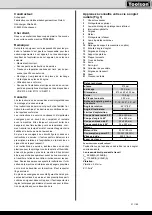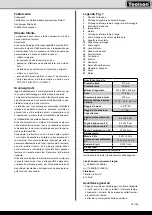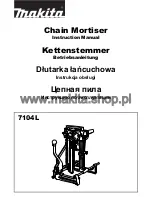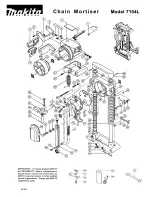
16 І 180
• Before making the cut, check that no collision could
occur between the stop rail (22 Fig.1.2) and the saw
blade (
8 Fig.1
).
•
Secure the locking lever (
23 Fig.1.2) again.
• Lift the saw unit by the handle (5 Fig.1) until it locks in
place in the top position.
•
Lock the material with the clamping device (
17 Fig.1)
on the fixed saw table to prevent the material from
moving during the cutting operation.
•
Press the workpiece evenly on the stop strips (
9
Fig.1
); make sure that you hand remains outside the
cutting area of the saw blade.
• With your right hand on the handle (5 Fig.1), press the
locking lever (
3 Fig.1
) so that the unit can also be piv
-
oted downward.
• The motor starts when the start button is pressed.
• Slowly bring the saw blade down to the workpiece and
cut through it with moderate pressure.
•
When the cutting operation is completed, move
the machine head back to its upper (home)
position and release the ON/OFF button.
Attention! The machine executes an upward stroke
automatically due to the return spring, i.e. do not re-
lease the handle (5 Fig.1
) after completing the cut; in
-
stead allow the machine head to move upwards slowly
whilst applying light counter pressure.
Mitre cut 0°- 45° (Fig. 1, 1.2, 3)
The crosscut saw can be used to make mitre cuts of
0° - 45° in relation to the work face.
Important. To make miter cuts (inclined saw head), the
adjustable stop rail (22 Fig.1.2
) must be fixed at the
outer position.
• Open the set screw (23 Fig.1.2) for the adjustable stop
rail (22 Fig.1.2) with an Allen key and push the adjust-
able stop rail outwards.
• The adjustable stop rail (22 Fig.1.2
) must be fixed far
enough in front of the innermost position that the dis-
tance between the stop rail (22 Fig.1.2) and the saw
blade (
8 Fig.1) amounts to a maximum of 8 mm.
• Before making a cut, check that the stop rail (22
Fig.1.2) and the saw blade (
8 Fig.1
) cannot collide.
•
Secure the locking lever (
23 Fig.1.2) again.
•
Move the machine head to the top position.
•
Fix the rotary table (
14 Fig.1) in the 0° position.
• Loosen the set screw (1 Fig.3) and use the handle (5
Fig.1) to angle the machine head to the left, until the
pointer (3 Fig.3) indicates the desired angle measure-
ment on the scale.
•
Re-tighten the fixing screw (
1 Fig.3).
• Cut as described in section “Cross-cutting”.
Bevel Cut
•
Loosen the bevel lock handle and move the cutting
head to the desired angle. Tighten the bevel lock han
-
dle.
•
Activate the switch, then press the blade guard lock
lever to lower the cutting head down.
This is a double insulated tool which eliminates the need
for an earthed power supply system.
WARNING! Avoid contact with the terminals on the
plug when installing (removing) the plug to (from)
the power supply outlet. Contact will cause a severe
electrical shock.
Using an Extension Lead
The use of any extension lead will cause some loss of
power. To keep this to a minimum and to prevent over
-
heating and possible motor burn-out, ask advice from a
qualified electrician to determine the minimum wire size
of the extension lead.
The extension lead should be equipped with an earthed
type plug that fits the power supply outlet at one end,
and with an earthed type socket that fits the plug of this
machine at the other end.
Mounting the Tool
Note:
We highly recommend that you bolt this mitre saw se-
curely to a work bench to gain the maximum stability of
your machine.
• Locate and mark the four bolt holes on the bench.
•
Drill the bench with a ø 10 mm drill bit,
• Bolt the mitre saw on to the bench with bolts, washers
and nuts. Note that these fasteners are not supplied
with the machine.
Operating the Tool
WARNING! Never connect the plug to the power
source outlet until all Installations and adjustments
are completed and you have read and understood
the safety and operational instructions.
Basic Pullover Mitre Saw Operations
•
Always use the clamp 17 to hold the work piece firmly.
2 holes are provided for the clamp.
• Always position the work piece against the fence. Any
piece that is bowed or warped and cannot be held flat
on the table or against fence may trap the blade and
should not be used.
•
Never place hands near the cutting area. Keep hands
outside the ”No Hands Zone” which includes the entire
table and is labelled by ”No Hands” symbols.
WARNING! To avoid injury from materials being
thrown, unplug the saw to avoid accidental starting,
and then remove small materials.
Cross-cutting (Fig. 1, 1.2, 6)
Attention! For 90° mitre cuts, the moveable stop rail
(22 Fig.1) must be fixed in the inner position.
• For chop cutting, slide the cutting head to the rear
position as far as it will go, and lock the carriage 1 by
the lock handle 2. (Fig.6)
• Open the set screw (23 Fig.1.2
) on the moveable stop
rail (22 Fig.1.2
) with an Allen key and push the move
-
able stop rail (22 Fig.1.2) inwards.
•
The moveable stop rail (
22 Fig.1.2) must be locked in
a position far enough from the inner position that the
distance between the stop rail (22 Fig.1.2) and the
saw blade (
8 Fig.1) is no more than 8 mm.
Summary of Contents for 3901208958
Page 110: ...110 180 RS RS RS RS Obja njenje simbola na instrumentu RS 0 RS...
Page 112: ...112 180 TOOLSON m...
Page 113: ...113 180 2 2 1 EN847 1 85dB A CE...
Page 116: ...116 180 7 3 1 7 8 7 1 50 10 6 1 2 1 2 6 6 1 5 1 2 3 1 3 4 2 45 7...
Page 117: ...117 180 25 1 5 2 25 2 5 2 16 Otklanjanje smetnji...
Page 149: ...BG II BG BG BG BG 0 BG 149 180...
Page 151: ...m 151 180...
Page 152: ...EN847 1 152 180...
Page 153: ...153 180 2 2 1 90 3 1 1 2 3 1 4 90 2 90 5 3 0 45 4 6 1 7 8 1 9 45 4 90 85dB A...
Page 157: ...157 180 VDE DIN H 07 RN 220 240 25 m 1 5 Motor Motor Machine Danger Engine Cut Dull...
Page 158: ...158 180 RU RU RU RU RU II 0 RU...
Page 160: ...160 180 m...
Page 161: ...161 180 EN847 1...
Page 162: ...162 180 2 2 1 90 3 1 1 2 3 1 4 90 85 A...
Page 166: ...166 180 VDE DIN H 07 RN 220 240 25 1 5 E 6 VDE DIN Cut...
Page 177: ...177 180...
Page 178: ...178 180...
















































